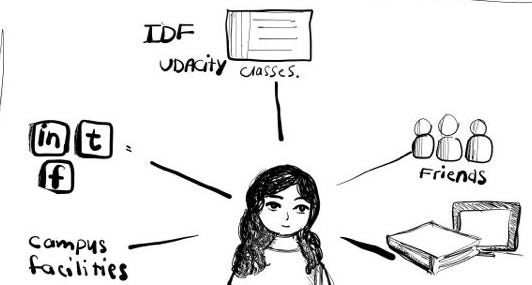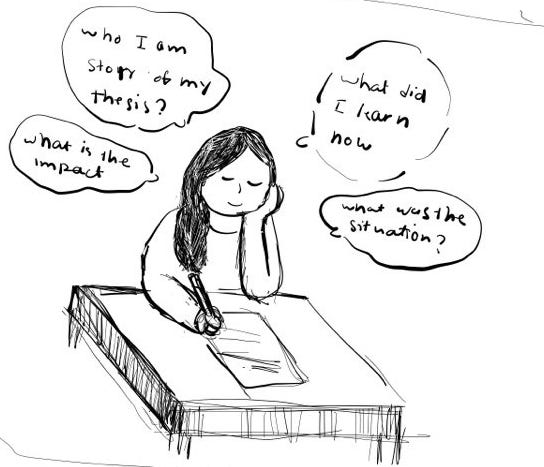I will start my internship in a company I like in a few days. It brings a deep smile to my face. However, this article is about the difficult moments behind this smile — moments when I lost my confidence and felt upset, hopeless, and insufficient. In the past few months, I had a lot of tough times during my internship search. I wanted to share my journey with those of you who are looking for internship opportunities in UX research. It might cheer you up to endure this somewhat cumbersome process. This article is a condensed version of my transition to UX research from the beginning to landing my dream internship.
First, a short bio of me: I am an international student from Iran, with a non-related degree: a Ph.D. in social geography. I have six years of experience in the architecture and design industry in Iran and the US.
It was around two years ago when I came across the UX field. I did not know the name of the field at that time, but I reached out to some professors outside of my department and learned about human-centered design. I found that it had many overlaps with what I was doing as an architect and urban designer. Here are the steps I took to transfer my urban design skills to UX:
– Are you a student? Start with your campus resources
One of the perks of being a Ph.D. is that you will typically stay in the program for four or five years. Therefore, you have time to explore what the campus offers you in terms of your broad interests.
- I became familiar with the concept of user experience research after discussing my ideas for my dissertation with one of the Design professors. With her advice, I registered for two courses in the Design department: Human-centered Design and Interactive Media. I further attended a course named “Design Thinking for Food” to help me solidify my design thinking skills with a project. During the past two years, I also did some independent studies and completed a few online courses related to different methods in UX research at Udemy and Interaction Design Foundation. In these courses, I learned various aspects of UX research and many technical skills such as programming languages. The universities also usually offer other programs to open doors for students who are interested in breaking into the industry. For example, I took courses and received a fellowship related to entrepreneurship and running startups. Those programs helped me learn about the business side of design, working in agile environments, business model canvas, and lean startup.

– Talk to your friends who have a related academic background or work in tech.
- I also tried to have techy conversations with my friends-both students and professionals- in engineering, anthropology, interactive design, or other related fields to UX research. I asked about their research, their work, etc. Accordingly, I became familiar with their technical terms. For instance, I learned using Github, some programming languages or how to search to address errors in coding, etc., mainly from these informal conversations.
- [disclaimer]: I learned this because of my job experience. I worked with engineers, social scientists, and designers in architecture firms and understood the more you talk with them in their language, the more they trust you and respond to your requests. This trust can also happen outside of the projects and technical talks. It can be while you are eating lunch and discussing what you did for the weekend.

- Additionally, I focused my dissertation on designing an app that improves young people’s critical spatial thinking so I could use it as a product research experience on my resume.
I used Linkedin and Facebook groups to talk to people and ask for informational interviews. The Facebook groups are:
Ph.D. to UXR — from academia to UX research
I also found mentors on Adplist and also UX Coffee hours. I asked them about my resume, the interview process, the required skills, etc. I also read a lot of articles on Medium and other UX-related platforms where people shared their experiences about UX research and how people with different academic backgrounds break into the field.
As everyone says during the interviews, you will likely experience a roller coaster of emotions. These recommendations might be helpful for you in this stage.
1- Be prepared to present your skills honestly :
What you need most for your presentation are your storytelling skills. Look at your background and achievements, and think about how your education/job experience or other life experience helped you grow UX skills. Some people recommend the STAR method for these personal stories which also can be helpful.

2- Get ready for the possible rejections
Rejections are unfortunate. They can happen at any stage of the interview process: in the first round, final round, or even when you do great in the interviews, etc. While rejections can be very upsetting, and it is normal to feel down after rejection for some time, try to consider every interview as a learning opportunity. Always ask the reason for the rejection. Most companies might not give you an accurate response, but you can consult your interview performance with your mentors. You can also write down how you did, what areas you can improve, etc. Additionally, you can find people who got that position on Linkedin and ask them about their performance and recommendations.
3- Keep applying until you sign an offer
You might do some stellar interviews but not hear back from the companies for more than a week. My recommendation is to continue applying no matter how strong your performance is or even receive verbal confirmation of hiring in the interviews. Keep applying till you sign the written offer.
Finding an internship is usually a cumbersome process. Reading other people’s journeys helped me a lot in bearing up the whole process of finding the right opportunity. You can also read Keana Richards and Esme Xu’s stories about getting their UX internships.
It took me six months to receive my first offer and another couple of weeks to get another offer, both from the companies I liked very much. I got these two offers after doing interviews with seven different companies. So trust me, your efforts will pay off some time. Keep doing the good work. Good luck! You got this!